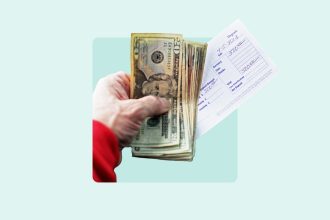For the first time since the early days of the coronavirus pandemic, Federal Reserve officials cut interest rates and signaled that even more could be coming.
In a more aggressive move than expected, the Federal Open Market Committee (FOMC) cut their benchmark borrowing rate by half of a percentage point, bringing the key federal funds rate to a new target range of 4.75-5 percent. In the weeks leading up to the meeting, economists thought the Fed would stick with a more modest quarter-point hike, even as investors upped their bets on the bigger move, according to CME Group’s FedWatch tool.
Fed officials also signaled that they plan to cut interest rates by half a percentage point more before the end of the year, according to their latest Summary of Economic Projections. In 2025, they expect another full percentage point of cuts.
Just one official, Fed Governor Michele Bowman, dissented against the decision. Bowman preferred a smaller quarter-point rate cut.
It’s a moment that many consumers have been waiting for, even if it does little to change the borrowing picture. Interest rates are now back to levels not seen since 2023. Before that, borrowing costs hadn’t topped their new level since 2007. Each Fed decision ripples through consumers’ pocketbooks. Rate cuts will translate to cheaper borrowing costs on auto loans, credit cards, and even mortgage rates down the road. On the flip side, yields on saving accounts and certificates of deposit will edge lower.
Interest rates are historically high because of the Fed’s fierce post-pandemic inflation fight. In the span of just a year and a half, the Fed hiked interest rates 11 times by the fastest pace in 40 years, bringing borrowing costs to a 23-year high of 5.25-5.5 percent.
The move signals a new era, though, for Fed Chair Jerome Powell & Co. After being hyper-fixated on high inflation, policymakers are now turning their attention to a slowing job market. Unemployment in July unexpectedly hit a three-year high of 4.3 percent, while employers created just 89,000 jobs in the month.
Joblessness has since edged lower, back to 4.2 percent, but it’s still risen faster than Fed officials thought it would just last June. In a pivotal August speech at a central banking symposium in Jackson Hole, Wyoming, Powell declared that the time for interest rates to adjust to a slowing economy has begun. Fed officials don’t want to see the job market slow down even more, he added.
Unlike during the Great Recession and the coronavirus pandemic, the Fed’s rate cut today isn’t about stimulating economic growth. By many other measures, the financial system remains stable, with growth in the third quarter of 2024 expected to hit 2.9 percent, according to the Atlanta Fed’s GDPNow forecast.
Rather, the Fed’s latest move is all about making sure the Fed avoids keeping interest rates too high for too long, needlessly slowing down the economy and — even worse — risking a recession. The bigger-than-expected move also reveals that officials want to prevent a slowdown officials have already been witnessing in the economy from getting even worse.
“The Fed was behind the curve when raising interest rates to corral inflation and the lesson appears to have been learned,” says Greg McBride, CFA, Bankrate chief financial analyst. “By making a larger half-point interest rate cut right from the get-go, the Fed is taking out some insurance against being behind the curve again.”
Interest rates are coming down
Bankrate’s experts react to the Federal Reserve’s first interest rate cut since 2020 and all the ways it could impact your personal finances
Follow along
The Fed’s interest rate decision: What it means for you
Savers
The one silver lining of a high-rate era has been historic yields on savings accounts and CDs. Rates have a long way to go before that changes.
Bankrate’s picks for the best high-yield savings accounts ranked for September 2024 currently offer an average yield of 5.1 percent, almost nine times the national average and 500 times higher than yields at Chase and Bank of America. They’re as high as 5.3 percent and as low as 5.01 percent. The market’s top-yielding online bank, meanwhile, is paying a 5.31 percent APY, Bankrate data shows.
All of those yields are higher than the current annual inflation rate of 2.5 percent, according to the latest data from the Bureau of Labor Statistics’ consumer price index (CPI). Parking your cash in a place where it’s rewarded — and where it can grow at a faster pace than prices — is what matters most to savers in the end.
Technically speaking, those so-called “real” returns on the nation’s high-yielding online banks are even greater than they were today, meaning you might be better off — even with a rate cut.
You also haven’t missed out on an opportunity to lock in a CD, though there’s no sense in waiting as rates officially begin to decline. If you already have at least six months’ worth of expenses stashed away in an emergency fund and can weather locking away your funds until maturity, consider complementing your portfolio with a guaranteed return.
Borrowers
Lower rates may take some of the edge off of the priciest financing costs in over a decade, but one rate cut won’t be a perfect remedy. The Fed’s key interest rate is still the highest in over a decade — and higher than at any point since the pandemic.
Credit card borrowers have had to learn that the hard way. The average credit card annual percentage rate (APR) is nearly 21 percent, according to Bankrate’s data.
Individuals grappling with high-interest debt should concentrate on chipping away at their balance as quickly as possible. The best balance-transfer cards on the market currently start Americans off with a 0 percent intro APR for as long as 21 months. If you’re able to clear your balance before your card provider shifts you back to the standard APR, you stand to accelerate your debt repayment and save hundreds — or even thousands — of dollars in interest. Just remember to calculate the price of transferring that balance, which is usually a one-off charge of 3 or 5 percent of the total debt that you transfer.
A falling-rate environment also underscores the importance of shopping around, comparing offers from multiple lenders and thinking twice about big-ticket purchases.
To be sure, you might not always be able to time the market. When the roof needs fixing or the car breaks down, you might not have the luxury of waiting for better interest rates. Yet, if you’re planning to borrow soon, it might pay to hold off on any big-ticket purchases that require financing, as the Fed expects to cut interest rates even more in the months ahead.
Homeowners and homebuyers
Last fall, mortgage rates were topping 8 percent, according to Bankrate data. Today, they’re hovering around 6.31 percent — a rapid drop as lenders adjust to the reality of lower interest rates.
A 6.31 percent mortgage rate is even lower than what economists in Bankrate’s quarterly forecast survey penciled in for the 30-year fixed-rate mortgage. The average forecast penciled in a mortgage rate of 6.6 percent by the end of the year, the poll found.
For the homeowners who locked in a mortgage when rates were at their peak, mortgage rates’ rapid descent means the refinance window has swung wide open. Borrowers are typically advised to start calculating how quickly they could recoup the cost of refinancing their debt if they can get an interest rate that’s at least half a percentage point lower than what they’re currently paying. Just be sure to weigh other factors, including how long you plan to stay in your home, according to McBride.
Rates still have a long way to go to help out would-be homebuyers. More than half of homeowners (52 percent) say they would need a mortgage rate lower than 6 percent to feel comfortable buying this year, according to Bankrate’s Mortgage Rates Sentiment Survey.
High mortgage rates are just one aspect of a challenging housing market. Home prices topped a new high for the fourth straight month, according to data from the Case-Shiller Home Index. Part of that is due to a supply shortage — and rates may still be too high to help alleviate it. Three in 10 current homeowners (30 percent) say mortgage rates need to be less than 5 percent for them to be comfortable selling their home this year, Bankrate’s Mortgage Rates Sentiment Survey also found.
Investors
For the most part, financial markets have been relatively upbeat throughout 2024. Rate cuts could fuel investors’ optimism. There’s also a chance that a storm could eventually rain on their parade.
Before the Fed’s September announcement, investors were pricing in 100 basis points worth of cuts by the end of the year. The stock market could be jittery if U.S. central bankers don’t end up following through.
Pay no mind to the bogeyman of the day. For the Americans who are investing in financial markets to save for long-term goals like retirement, their best allies are a diversified portfolio and time. Retirement can last several decades, during which you may live through low-rate eras, inflationary periods and more.
Read the full article here














